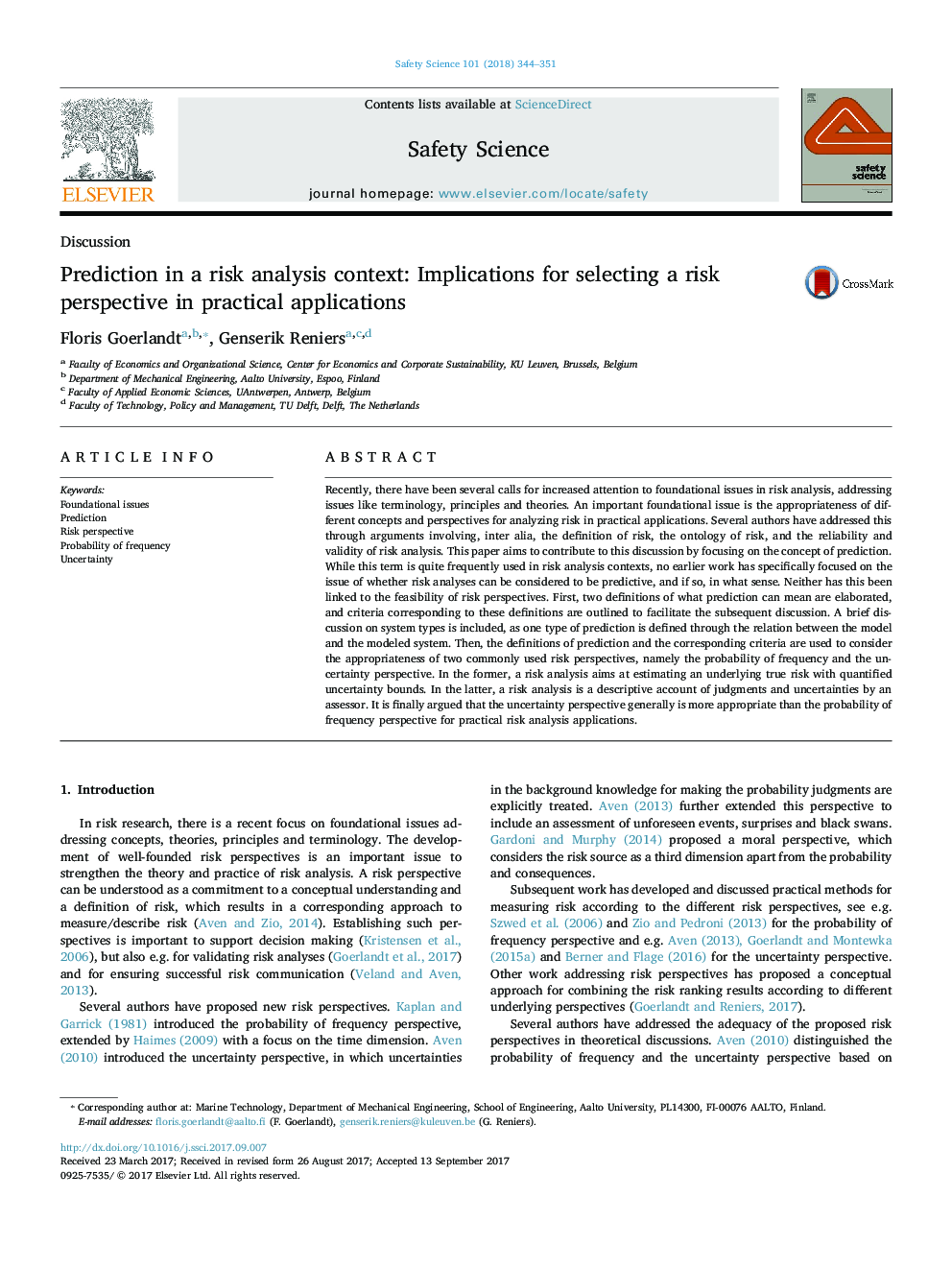| کد مقاله | کد نشریه | سال انتشار | مقاله انگلیسی | نسخه تمام متن |
|---|---|---|---|---|
| 6975180 | 1453371 | 2018 | 8 صفحه PDF | دانلود رایگان |
عنوان انگلیسی مقاله ISI
Prediction in a risk analysis context: Implications for selecting a risk perspective in practical applications
ترجمه فارسی عنوان
پیش بینی در زمینه تجزیه و تحلیل ریسک: اثرات انتخاب یک دیدگاه ریسک در کاربردهای عملی
دانلود مقاله + سفارش ترجمه
دانلود مقاله ISI انگلیسی
رایگان برای ایرانیان
کلمات کلیدی
مسائل پایه، پیش بینی، دیدگاه ریسک، احتمال فرکانس، عدم قطعیت،
ترجمه چکیده
اخیرا، چندین فراخوان برای افزایش توجه به مسائل بنیادی در تحلیل ریسک وجود دارد، و به موضوعاتی همچون اصطلاحات، اصول و نظریه ها پرداخته شده است. یک مسئله اساسی مهم، مناسب بودن مفاهیم و دیدگاه های مختلف برای تحلیل ریسک در کاربردهای عملی است. تعدادی از نویسندگان این موضوع را از طریق استدلال هایی که شامل تعریف ریسک، هستی شناسی ریسک و اعتبار و اعتبار تجزیه و تحلیل ریسک است، مورد بحث قرار داده است. این مقاله با هدف تمرکز بر مفهوم پیش بینی، به این بحث کمک می کند. در حالی که این اصطلاح به طور گسترده ای در زمینه های تحلیل ریسک استفاده می شود، هیچ کار قبلی به طور خاص در مورد این که آیا تجزیه و تحلیل ریسک می تواند به عنوان پیش بینی در نظر گرفته شود یا خیر، و در صورت لزوم، به چه معناست، متمرکز شده است. این موضوع به امکان دیدگاههای ریسک ارتباطی ندارد. اولا، دو تعریف از آنچه پیش بینی می تواند به معنی است توضیح داده شده، و معیارهای مربوط به این تعاریف برای تسهیل بحث بعدی است. بحث مختصر در مورد انواع سیستم ها گنجانده شده است، به عنوان یک نوع پیش بینی از طریق رابطه بین مدل و مدل مدل تعریف شده است. سپس تعاریف پیش بینی و معیارهای مربوطه برای در نظر گرفتن تناسب دو دیدگاه رایج مورد استفاده قرار می گیرند، یعنی احتمال وقوع فرکانس و عدم اطمینان. در ابتدا، تحلیل ریسک با هدف برآورد ریسک حقیقی پایه با محدودیت های نامشخصی محاسبه می شود. در دومی، تحلیل ریسک یک توصیف توصیفی از قضاوت و عدم اطمینان توسط یک ارزیابی است. در نهایت استدلال می شود که دیدگاه عدم اطمینان به طور کلی مناسب تر از احتمال احتمال فرکانس برای برنامه های کاربردی تجزیه و تحلیل خطر است.
موضوعات مرتبط
مهندسی و علوم پایه
مهندسی شیمی
بهداشت و امنیت شیمی
چکیده انگلیسی
Recently, there have been several calls for increased attention to foundational issues in risk analysis, addressing issues like terminology, principles and theories. An important foundational issue is the appropriateness of different concepts and perspectives for analyzing risk in practical applications. Several authors have addressed this through arguments involving, inter alia, the definition of risk, the ontology of risk, and the reliability and validity of risk analysis. This paper aims to contribute to this discussion by focusing on the concept of prediction. While this term is quite frequently used in risk analysis contexts, no earlier work has specifically focused on the issue of whether risk analyses can be considered to be predictive, and if so, in what sense. Neither has this been linked to the feasibility of risk perspectives. First, two definitions of what prediction can mean are elaborated, and criteria corresponding to these definitions are outlined to facilitate the subsequent discussion. A brief discussion on system types is included, as one type of prediction is defined through the relation between the model and the modeled system. Then, the definitions of prediction and the corresponding criteria are used to consider the appropriateness of two commonly used risk perspectives, namely the probability of frequency and the uncertainty perspective. In the former, a risk analysis aims at estimating an underlying true risk with quantified uncertainty bounds. In the latter, a risk analysis is a descriptive account of judgments and uncertainties by an assessor. It is finally argued that the uncertainty perspective generally is more appropriate than the probability of frequency perspective for practical risk analysis applications.
ناشر
Database: Elsevier - ScienceDirect (ساینس دایرکت)
Journal: Safety Science - Volume 101, January 2018, Pages 344-351
Journal: Safety Science - Volume 101, January 2018, Pages 344-351
نویسندگان
Floris Goerlandt, Genserik Reniers,
